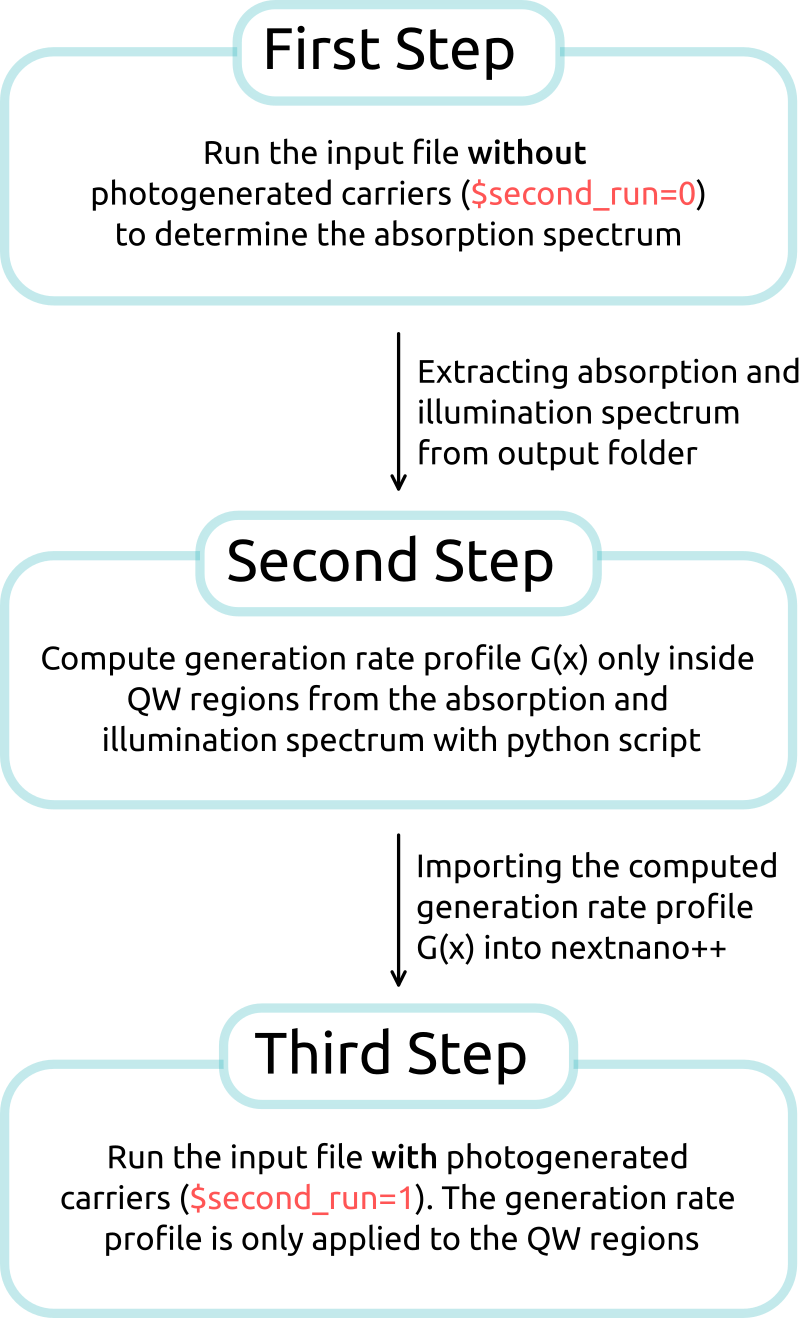5.6.10. Resonant photoluminescence of InGaAs/GaAs QWs
Attention
Input files for this tutorial has been recently modified and are not yet released. Please contact our nextnano support team to learn about their availability.
Header
- Files for the tutorial located in nextnano++\examples\quantum_wells
PL_resonant_QW_III-V_single.nnp
PL_resonant_QW_III-V_single.py
PL_resonant_QW_III-V_double.nnp
PL_resonant_QW_III-V_double.py
- Important keywords:
- Relevant output files:
bias_00000\OpticsQuantum\quantum_region\absorption_coeff_spectrum_TE_eV.dat
Irradiation\illumination_spectrum_power_eV.dat
Structure\generation_fixed.dat
bias_00000\bandedges.dat
bias_00000\OpticsQuantum\quantum_region\spont_emission_spectrum_photons_TE_eV.dat
Introduction
This tutorial shows an approximate simulations of resonant photoluminescence of a quantum well. Multiple approximations are used in this case, hence the results are expected to be a rough estimation. For example, the wave nature of electrons and photons has been mostly neglected when calculating generation rates. Here, a Fermi’s golden rule is used to model absorption spectrum which are further renormalized to the width of the quantum well and assumed to be constant within the quantum well. Then position-dependent generation rate is calculated with Beer’s law. Once the generation rate is calculated, it is imported to the same simulation to recalculate the spectra. As the imported generation splits the quasi-Fermi levels, emission form the pumped system is calculated.
A simple 1D single (double) In0.2Ga0.8As/ GaAs QW structure under illumination along the QW growth direction is considered. The light intensity entering the system has is given by a gaussian distribution with the mean energy a little above the absorption edge of the GaAs QW. The In0.2Ga0.8barriers are assumed to be transparent for the incident photons as the band gap is higher that their energy. Thus generation of charge carriers only occurs inside the QW.
Simulation Scheme
The simulation procedure shown in Figure 5.6.10.1 is employed.

Figure 5.6.10.1 Visualization of the Simulation Procedure
The simulations are coded in PL_resonant_QW_III-V_single.nnp (PL_resonant_QW_III-V_double.nnp) while the the entire procedure is realized automatically by the script PL_resonant_QW_III-V_single.py (PL_resonant_QW_III-V_double.py).
First Step
In the first step, data files for the absorption spectrum and the illumination spectrum are created, which are going to be used to determine the generation profile \(G(x)\), in a later step.
The illumination spectrum, photon flux \(\Phi(E)\), Irradiation\illumination_spectrum_power_eV.dat is defined inside the group optics{ global_illumination{ } }.
Absorption coefficient spectrum \(\alpha(E)\) of the quantum well \bias_00000\OpticsQuantum\quantum_region\absorption_coeff_spectrum_TE_eV.dat is computed within optics{ quantum_spectra{ } }
The absorption spectrum is renormalized to the width of the quantum well (or two quantum wells) within the input file, as only the part related to the confined transitions is later considered for the photogeneration
Figure 5.6.10.2 Computed absorption spectrum of a single InGaAs/GaAs quantum well for different quantum region widths \(L_q\) (a) normalized to the width of the quantum region \(L_q\), and (b) normalized to the thickness of the QW \(L_q\).
Second Step
With the python script, the generation rate profile \(G(x)\) is calculated as follows:
where \(G(x,E)\) is given by
with the spectral photon flux \(\Phi(E)\) and absorption coefficient \(\alpha(E)\). Reflectance is neglected in this case. The factor \(\Phi(E)e^{-\alpha(E)x}\) represents the light field which attenuates exponentially along the propagation direction.
The spectral photon flux is determined by the spectral properties of the light source, i.e., the light source spectrum \(dI/dE\), as follows:
with energy \(E\).
Third Step
The generation rate profile is imported from the data file with generation functions saved next to the python script. The file should contain values for position and generation rate as separate columns.
Then the input file is called again with modified setting, enabling importing of teh generation rates. The importing is defined in the group import{ } and properly assigned to the quantum well region in structure{ region{ generation{ } injection{ } } }
Results
Figure 5.6.10.3 bias_00000\bandedges.dat - Energy profiles without generation, of (a) a single QW and (b) double QW. Note that the Fermi levels are flat.
Figure 5.6.10.4 Irradiation\illumination_spectrum_power_eV.dat and bias_00000\OpticsQuantum\quantum_region\absorption_coeff_spectrum_TE_eV.dat - (a) Illumination power, (b) absorption coefficient spectra for both single and double QWs
Figure 5.6.10.5 Structure\generation_fixed.dat - Generation rate imported to a simulation with (a) a single QW and (b) double QW.
Figure 5.6.10.6 bias_00000\bandedges.dat - Energy profiles with generation, of (a) single QW and (b) double QW. Note that the Fermi levels are no flat.
Figure 5.6.10.7 bias_00000\OpticsQuantum\quantum_region\spont_emission_spectrum_photons_TE_eV.dat - Power emission spectra before and after generation rates are imported to the simulations of (a) a single QW and (b) double QW.
Last update: 2025-10-23